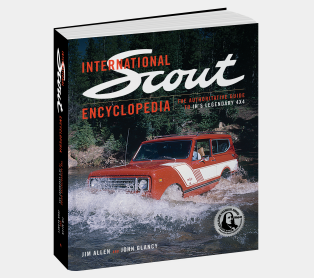Cracking the Books

Enthusiasts will learn all there is to know about Scouts in the revised edition of the International Scout Encyclopedia. This book gives the only Scout book you'll ever need a shelf-mate! The companion edition features new information on the most collectible trucks, a new section identifying all the appliqués offered, an expanded index, and tweaks and updates throughout.
To Scout collectors—any car collector really—documentation is a big part of the hobby. Not only does it offer you a bit of armchair time travel to the thrilling days of your Scout's yesteryears, it offers you information and data for a restoration. Original documentation is sometimes hard to find but here are a few tips for IH documentation that help you focus in on the most useful materials.
Bear in mind that the documentation for Scouts came from several sources within International and each source had their own flavor. Sometimes even a different way of numbering the documents. We can't cover it all but let's overview the most commonly available sources of documentation available to restorers and collectors.
Brochures and the Authenticity Trap
Collecting car brochures and advertising is a hobby in itself but one of the first things most Scout owners do is find a brochure for their year and model. They make a great item to display with your Scout but brochures are not always the best guides to originality for many reasons. Here's why.
As the company prepared for the new model year, or the intro of a new model, they had to have brochures ready well before the actual launch. Many times they were making the brochures and other advertising materials before the new models were coming off the line. In order to get the images shot, they sometimes used preproduction models and even previous year models with some of the key visual changes made. Those rigs could be missing small details that appeared on the production models.
Brochures also underwent revisions to reflect changes in product specifications and options. Even assuming production models were used in the photography, the brochure you are looking is really just a snapshot of a particular time that may or may not fit your particular Scout. Sometimes a discontinued paint color was shown. Options may be shown that were deleted by the time your rig was built. Sometimes the listed options changed several times in the course of a model year. The bottom line is that you may get bite marks if you use images in a brochure as your only guide to a detailed restoration. Use the brochure as one part of your research and back it up with other sources.
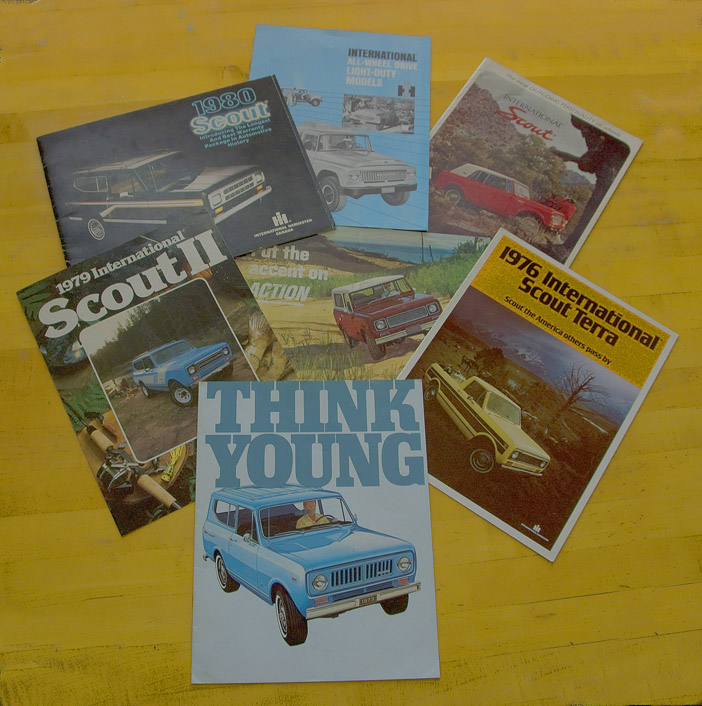
Above is an array of sales procures from various eras. These were printed by the tens of thousands and are the most readily available period documentation for your Scout. They are a mix of photographic images and artist's renderings.
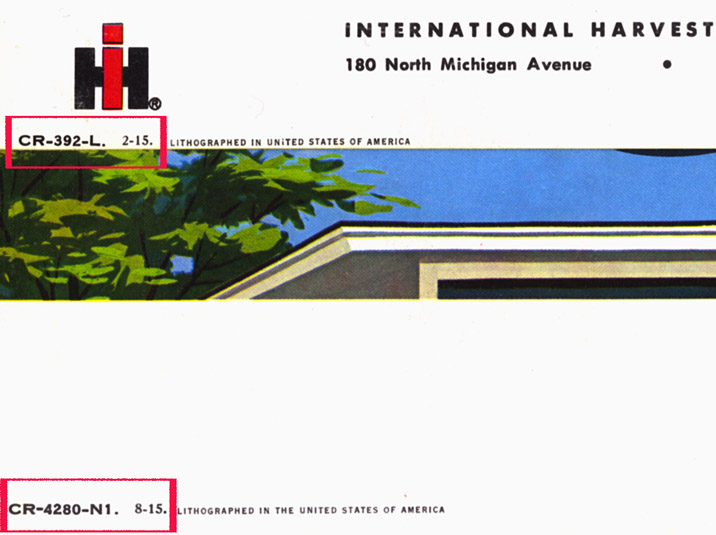
The image above includes two date codes from the early Scout 80 era. See also the list below, but in the Scout era, there are three prefixes in the document codes, "CR" or "AD" for the U.S. and "CA" for Canada. The top number is from a 1961 first edition brochure ("L") and the bottom a second edition from 1962 ("N1"). As you see from the chart, the letter suffix indicates the calendar year (not model year) and a number that follows indicates a revision. The numbers that follow, in these instances "2-15" and "8-15," have long been associated with the month and date of production, but this has not been confirmed. Those numbers don't always correlate with when some of the brochures are known to have appeared.
Above is a '63 brochure that could mislead a restorer. Note the black and white seats and the vestigial parts of the bulkhead on the Scout on the right. These indicate a very short term and temporary modification done from late '62 into early '63. Called the Interim Walk Thru conversion, it cut a walkway through the permanently installed bulkhead for rear seat access and had a special seat option to go with it. It was temporary because IH was reengineering the Scout body for the now more familiar removable bulkhead. The clamoring for a true station wagon Scout led them to the temporary solution done in limited numbers on the assembly line, or via a kit by dealers. This is discussed in some detail in Scout Encyclopedia. This brochure for the '63 model year shows the interim conversion and the black and white seats. The black and white seats were also temporary until a different style appeared late in '62. If a restorer used this as a guide without knowing the Interim Walk-Thru story, he would be shooting himself in the foot.
Line Setting Ticket
Because you have an International Harvester product, you are blessed by the fact that IH put many of the old build records onto microfilm and those records are accessible. The Wisconsin Historical Society (WHS) has a copy of the full set of microfilm and you can order up a full copy of your Line Setting Ticket (LST), which is the build sheet for your rig. It will list exactly how your Scout or IH rig was originally outfitted, barring any changes or upgrades the dealer might have done before sale. Though there are rare exceptions, the LST can be considered a 100 percent guide to how your rig was built. If you acquire no other documentation for your IH rig, get the LST.
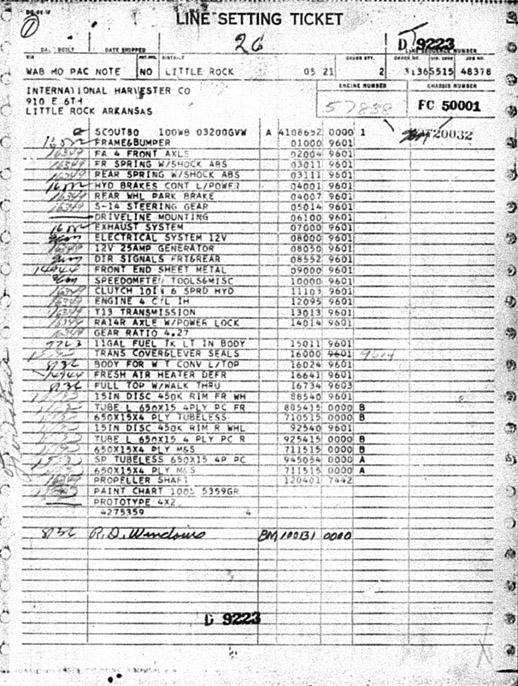
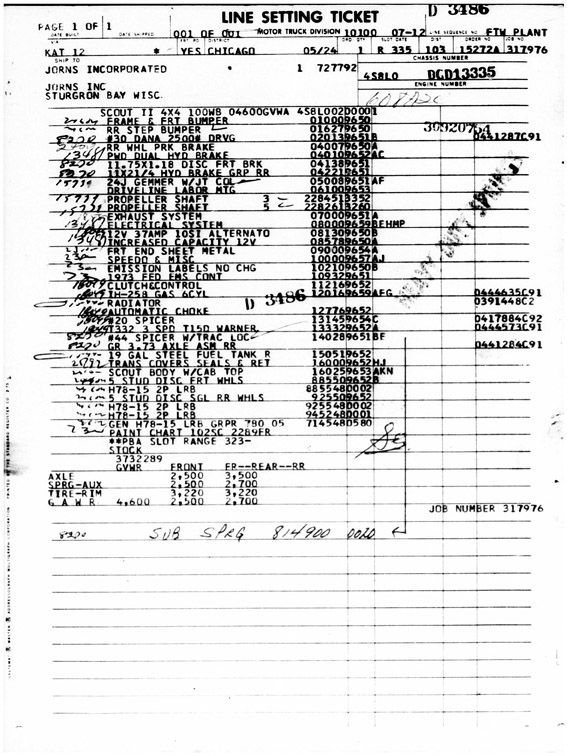
Above are two Line Setting Tickets from both ends of the Scout timeline, Scout 80 and Scout II, from the Wisconsin Historical Society. A downsized and abbreviated version of this is on the Scout itself, exact location varying by era, but the years have often made them partially or fully illegible, or they deteriorate completely. The sample LSTs shown are good, readable examples but not all are. The records are on microfilm and for various reasons we won't delve into, the quality of the images is spotty. Even on the worst ones, you can read most of it. WHS scans the microfilm images with a hi resolution scanner but the results are only as good as the image being scanned. A bad copy is often more easily read in it's original digital PDF form than as a printout. You can blow it up on your screen and if you have any corrective image software you can improve the image.
Original Dealer Invoice
If you have the original sales invoice and/or window sticker (called a Monroney after the U.S. Senator that sponsored the legislation that required them in 1958), you have some originality gold. Not only can you see who originally bought your rig, but the dealership where it was sold, the price that was paid and any extras that were installed by the dealer. One of the bigger quandaries faced by a faithful restorer is whether a particular item is factory original or not.
The sales invoice often details what was part of the factory package and what was dealer installed. Dealer installed doesn't always mean "factory approved" either, as dealers had their own sources for accessories and upgrades. Exterior graphics is one source of head scratching, especially in the Scout II era when they were sold in big city areas where customs graphics companies existed. This is one reason why we added the Appliqué Guide to the 2nd Edition of Scout Encyclopedia. If it isn't on that list, and it isn't from one of the known upgraders like CVI, Midas, Van American, etc., it's probably a graphics kit put on by the dealer or by an owner long after sale. Would love to show you an invoice, but the ones in our possession have personal details of people that are best not revealed online. By the way, if you have a Scout with vintage graphics you can't identify, contact the authors via Octane Press and we'll help you figure it out.
Product Data Book
Every year, IH created a Product Data Book that contained all the available options and specs for that model year. It was regularly updated through the year to reflect changes in configuration and options. They usually started with a preliminary book created before the new models were even out. In a perfect world, collectors would have access to all the different versions and could do their restoration based on the era in which their Scout was built. Yeah, that's not a very likely scenario for most collectors but be aware there can be significant differences within a model year.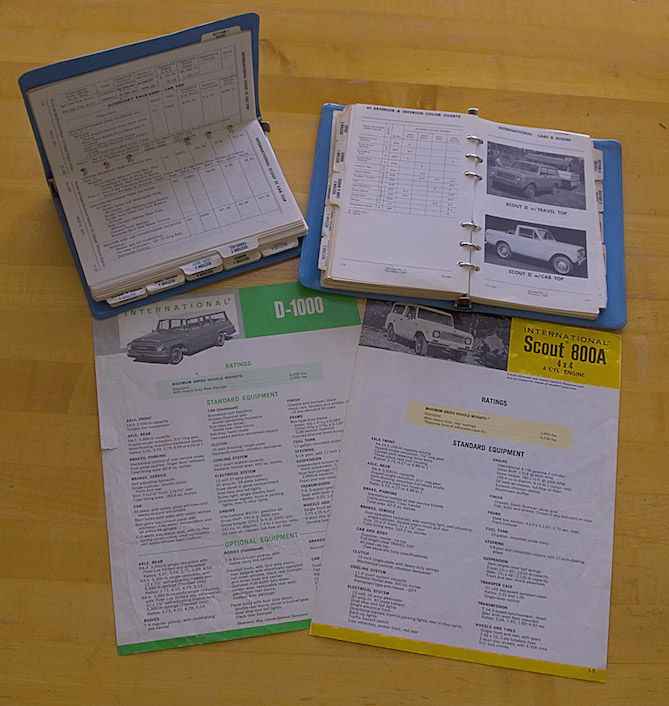
Here are two Product Data Books from the early Scout II era (top) and pages from the Scout Section of a 1970 800A era data book in a larger format. The Scout II era books are the smaller CT-402 data books that contain only the light duty materials. The larger pages are pages from the CT-400 data book that has a larger format and contains all the IH motor truck division materials, light, medium and heavy. There were many IH dealers that did not sell light duty at all, so their books would not have the light duty product pages inserted, but they all show the component specs pages that included light duty, such as very techy details on axles, engines and gearboxes.
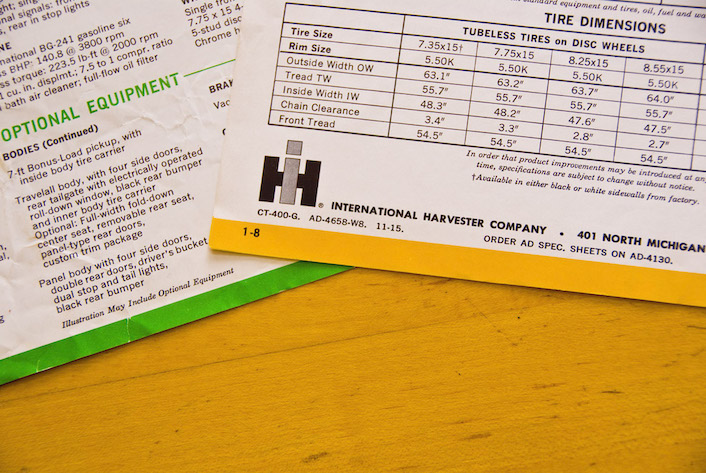
Data Book pages use coding just like brochures. In this case, the Scout page is identified as the 8th variation of a 1970 ("W") document.
Price Book
Again, there were many variations and updates to these over the course of a model year, so each book is a snapshot of that moment in time. Of course, prices went up and down but options changed as well. Another consideration is whether it's a preliminary booklet or not. A two to three months before the new models came out, dealers would be sent advance information and specifications on the new models. Needless to say this was subject to change.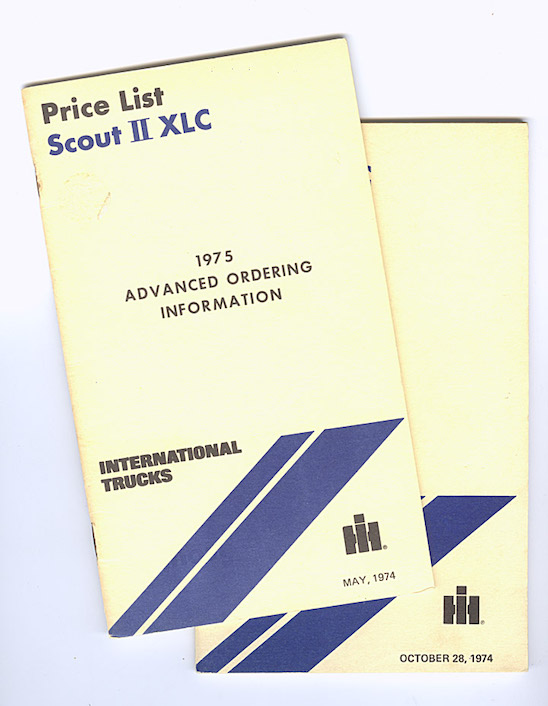
The Advance Ordering and Price Book for the 1975 model year Scout, both printed in 1974. The one dated October 28, 1974, may seem early but it's the 11th Edition of the 1975 Price book and there are significant price differences between it and the 10th Edition dated September 16, 1974. The preliminary book does not list prices in this case and you can see some difference in options packages between it and the later books.
Sales Engineering Bulletin
These appeared irregularly at different times, usually along with a major update to the line. Sales Engineering Bulletins (SEB) also delivered competitive comparison materials that offered sales people insight on comparing competitive products when customer asked. The competitive stuff is more funny the useful but those that highlighted updates to the product can be very useful.
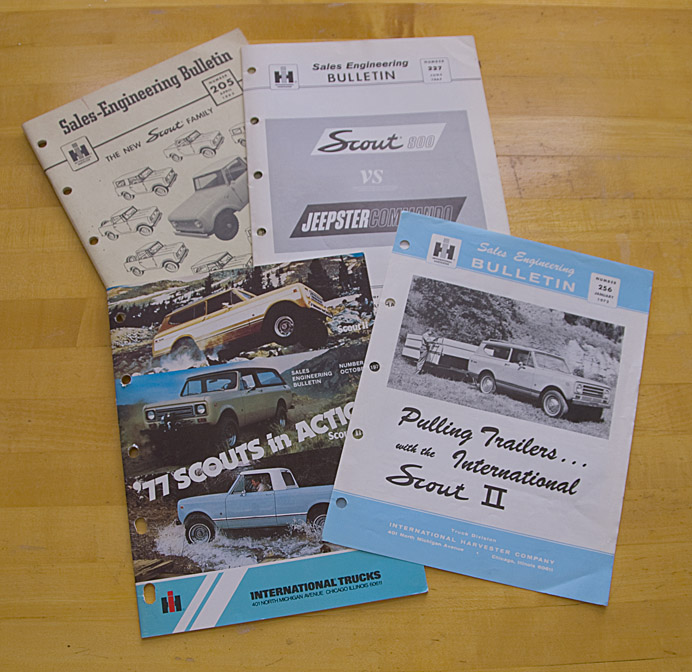
Three examples of Sales Engineering Bulletins that could be very useful and one that's just fun. From the top left is the April 1963 bulletin (number 205) that shows in detail all the many upgrades to the Scout 80 that year. On the top right is number 227 from June of 1967 with a competitive comparison of the 1967 800 with the new 1967 Jeep Jeepster Commando. That one is probably more fun than useful. On the lower left is number 600 from October 1976 highlighting the 1977 model Scouts. The lower right is number 256 from January 1972 illustrating the towing capabilities of the new Scout II.
Gold Star Or Gold Key Models Booklet
These began in the 800B era as the Gold Key book and were an offshoot of a quick ordering system that originated in the 1950s. Basically, the sales and marketing departments, along with the regional offices, came up with build configurations they thought dealers and customers would like and gave them one number or ordering. Late in 1973, the Gold Star Plan debuted and it was even more expansive. A dealer could go thru the Gold Star Book and with one number order a popular combination of options. It saved the agony of going through an order sheet and painstakingly marking boxes, hoping you didn't accidentally order options that conflicted. If your Scout was ordered from a Gold Star Book, it would have that code on the LST and then you'd know what you got.
Through the Scout II era, you might find a number like: "5-SCTT-44-118." That breaks down thusly: 5= the model year, 1975; SCTT= Scout Travel Top (alternatives were SCCT for a Cab top, SCTR for a Traveler and SCPU for a Terra); 44= Scout Line, 118= the particular combo. That didn't mean there were 118 or more combos for '75, that was just the 118th done so far. Sometimes a combo reappeared in a different year using the same number, sometimes a combo disappeared and new ones were added to the total.
In eras that predated Scout II, you might see "Prototype 4x4" or "Prototype 4x2" on the LST. People often get very excited seeing the word "prototype" on their LST but in IH-speak, it simply meant a particular standard build configuration. With special models, such as Comanche, you might see "Comanche Prototype #5" indicating a particular combination within the Comanche line. The early days were simple but not always consistent. The Gold Star System really coalesced in the Scout II era and is a valuable resource.
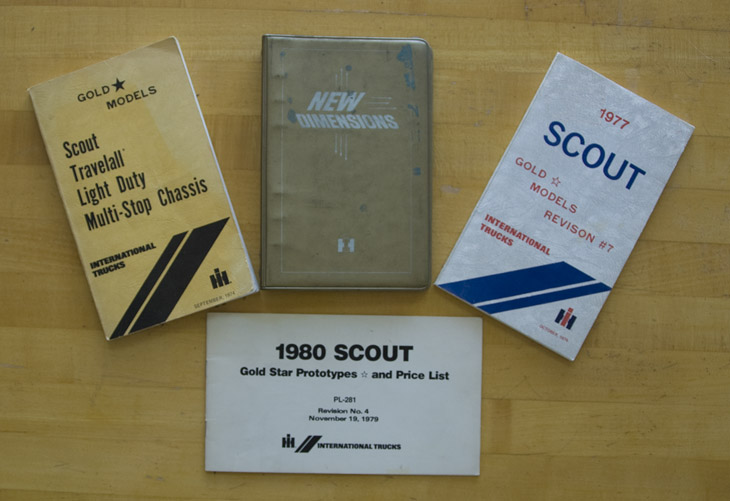
Gold Star manuals from various eras. The center book, conveniently in gold is one of the first, Revision 9 dated February, 1974. The Gold Star Plan was announced on August 16, 1973, for the 1974 model year. The yellow booklet to the left is from September of 1974 for the 1975 model year and is the 2nd Revision. The 77 book is the 7th Revision and the 1980 is the 4th Revision. Yeah, if you want a complete set, you'd have a goodly number to look for. The changes can be relatively minor but many times a new Gold Star Model was added.
Sources
Wisconsin Historical Society, McCormick Collection
Order Line Setting Tickets
Find a Scout Light Line Dealer
Date Codes on Scout Literature
On the last page of most IH sales documents is a suffix code that will help you date it. An example would be AD-4658-W8. "AD" is the U.S. prefix, which starts in 1965 and runs past the demise of the Scout. "CT" preceded it. The "4568" is the individual document number. "W" indicates the year, 1970, and the "8" is for the revision.
1959-1981 Shown U.S., 1959-68 Shown Canada
"CR" Prefix "AD" Prefix" "CA" Prefix
I- 1959 R- 1965 N- 1959
K- 1960 S- 1966 O- 1960
L- 1961 T- 1967 P- 1961
M- 1962 U- 1968 Q- 1962
N- 1963 V- 1969 R- 1963
P- 1964 W- 1970 S- 1964
X,Y,Z- 1971 T- 1965
A- 1972 U- 1966
B- 1973 V- 1967
B/C- 1974 W- 1968
C- 1975
D- 1976
E/F- 1977
G-1978
H- 1979
J- 1980
K- 1981
If you have questions, email Octane Press.


